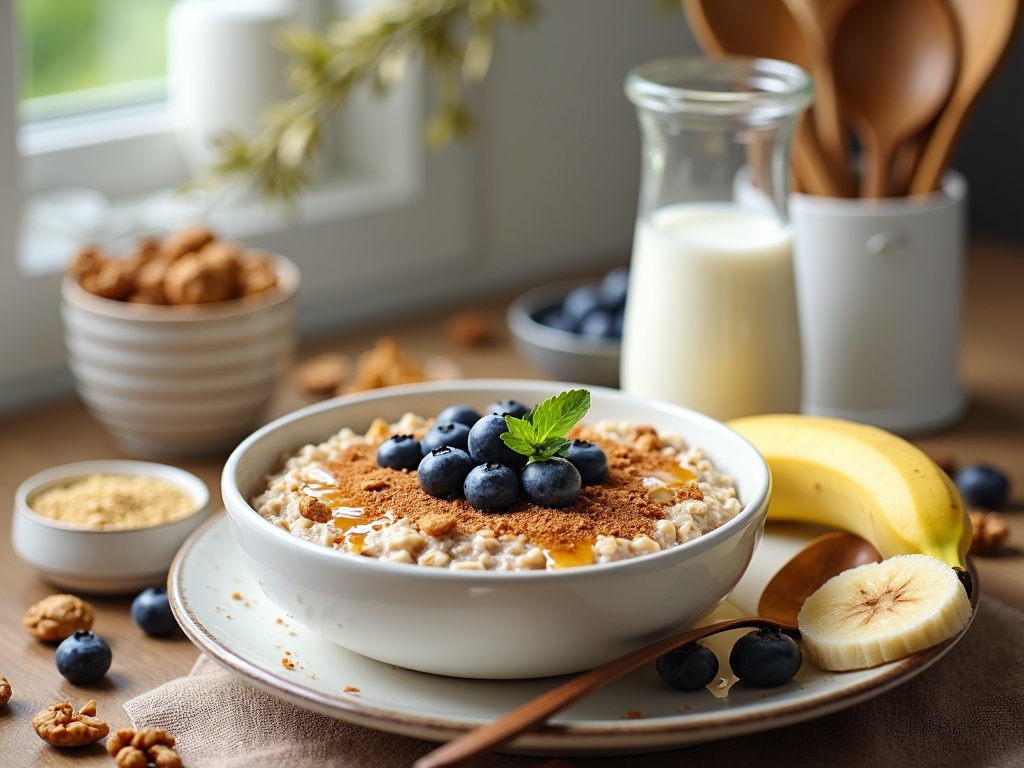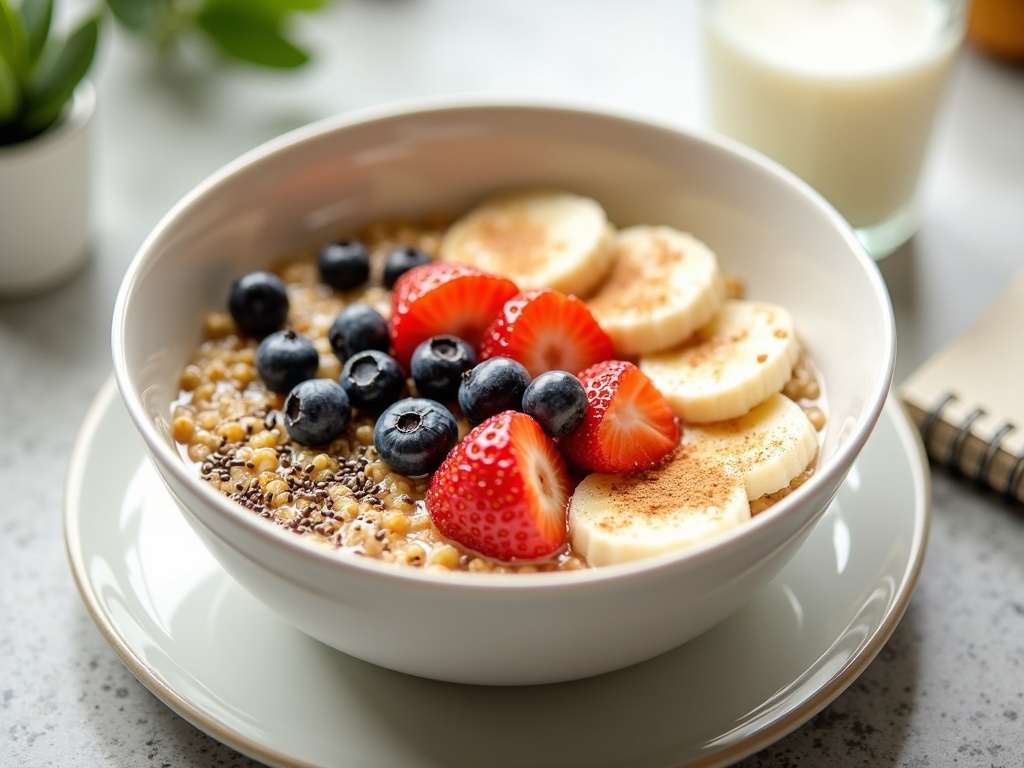Starting your day with a low FODMAP breakfast can significantly reduce digestive discomfort for people with IBS, with research showing that 75% of sufferers experience relief when following this specialized diet. A carefully planned morning meal sets the foundation for how your digestive system functions throughout the day, potentially preventing cascading symptoms like bloating, gas, and abdominal pain that might otherwise persist for hours.
Find In This Article
Key Takeaways
- Low FODMAP breakfast choices help minimize uncomfortable bloating, gas, abdominal pain, and unpredictable bowel habits in IBS sufferers.
- Gluten-free oats, quinoa flakes, almond milk, and lactose-free milk form excellent breakfast bases when prepared in appropriate portions.
- Fruits must be carefully selected and portioned – options like strawberries, blueberries, and firm bananas are suitable in specific amounts.
- Common mistakes include overlooking hidden FODMAPs on ingredient labels, using overripe fruits, and consuming inappropriate portion sizes.
- Personalization is essential for success as individual tolerances to specific FODMAPs vary considerably.
Quick Relief: What Makes Low FODMAP Breakfast Important
Finding the right breakfast when dealing with irritable bowel syndrome (IBS) can transform your entire day. I’ve discovered that starting with a low FODMAP breakfast is crucial for managing symptoms and setting a positive tone for the hours ahead.
The Science Behind Symptom Relief
Low FODMAP diets aren’t just a trend—they’re backed by solid research. According to the American Journal of Gastroenterology, 75% of IBS sufferers experience significant symptom relief when following a low FODMAP diet. This approach specifically targets fermentable carbohydrates that can trigger digestive distress in sensitive individuals.
The morning meal deserves special attention because it establishes how your digestive system will function throughout the day. By choosing low FODMAP breakfast foods that avoid problematic ingredients, you can minimize:
- Uncomfortable bloating that makes clothing feel tight
- Embarrassing and painful gas
- Persistent abdominal pain that disrupts daily activities
- Unpredictable bowel habits that create anxiety
Starting your day with trigger foods can initiate a cascade of symptoms that might last hours or even the entire day. That’s why I prioritize breakfast planning for IBS management.
Personalizing Your Morning Routine
What works for one person might not work for another. Individual tolerances to specific FODMAPs vary considerably, making personalization essential for success. I’ve found that gluten-free breakfast options often form a good foundation, but you’ll need to discover your unique trigger foods.
Some people tolerate small amounts of certain FODMAPs, while others need strict elimination. Through careful experimentation, you can create a breakfast rotation that includes:
- Gluten-free porridge made with allowed grains
- Overnight oats prepared with low FODMAP fruits
- Savory oatmeal dishes featuring permitted vegetables
- Healthy pancakes using low FODMAP flours
Before making any significant dietary changes, I must emphasize consulting with a healthcare professional. A registered dietitian who specializes in digestive disorders can provide structured guidance through the elimination and reintroduction phases, ensuring you maintain proper nutrition while identifying your specific triggers.
The right low FODMAP breakfast isn’t just about avoiding symptoms—it’s about reclaiming your mornings and establishing a foundation for comfortable, productive days. With proper planning and professional guidance, breakfast can become an enjoyable, symptom-free start to your day.

Essential Low FODMAP Breakfast Ingredients and Portions
Starting my day with a low FODMAP breakfast has made a huge difference in managing my digestive symptoms. I’ve found that having the right ingredients in the proper portions is key to creating satisfying meals that don’t trigger discomfort.
Base Ingredients for Low FODMAP Breakfasts
Gluten-free oats have become my morning staple. They’re incredibly versatile and perfect for creating nutritious overnight oats that save me time on busy mornings. Quinoa flakes offer another excellent alternative when I want to switch things up. For the liquid component, I stick to either almond milk or lactose-free milk, keeping it to about 1 cup per serving.
Chia seeds add a powerful nutritional boost to any gluten-free breakfast porridge, and I typically use 1-2 tablespoons. They’re packed with omega-3 fatty acids and fiber that keeps me full until lunchtime.
When it comes to fruits, I’m careful to choose low FODMAP options in appropriate portions. About half a cup of fresh or frozen blueberries or strawberries works perfectly in my gluten-free breakfast bowls. If I’m craving banana, I stick to half of a firm, unripe banana, as ripe bananas contain higher amounts of FODMAPs.
Toppings and Flavor Enhancers
The right toppings can transform a basic breakfast into something special. I add 1-2 tablespoons of unsalted peanuts or walnuts for crunch and healthy fats. For sweetness, a tablespoon of maple syrup or brown sugar is usually enough, though these should be adjusted based on personal taste and dietary needs.
Cinnamon has become my go-to spice for adding warmth and flavor without any FODMAP concerns. It pairs beautifully with both sweet and savory oatmeal dishes and offers anti-inflammatory benefits as a bonus.
These ingredients create the foundation for countless healthy breakfast options that won’t trigger IBS symptoms. I can make everything from simple porridge to elaborate healthy pancakes using these low FODMAP building blocks. By keeping track of portions and combining these ingredients thoughtfully, I’ve created a breakfast routine that’s both gut-friendly and delicious.

Creating Your Perfect Low FODMAP Breakfast Bowl
Breakfast bowls have become my go-to morning meal when managing IBS symptoms. They’re customizable, satisfying, and when made with the right ingredients, completely low FODMAP friendly. I’ve perfected a simple method that delivers delicious results every time.
The Perfect Base
I start by combining certified gluten-free oats or quinoa flakes with almond milk in a medium saucepan. This creates a digestive-friendly base that won’t trigger symptoms. For extra nutrition and that perfect creamy texture, I add a tablespoon of chia seeds before turning on the heat.
Cooking takes just 5-10 minutes over medium heat, stirring frequently until the mixture thickens to my preferred consistency. This is where patience pays off – rushing this step can lead to a gummy texture. Once it reaches that perfect thickness, I remove it from heat and let it rest for about 2 minutes, allowing the chia seeds to continue expanding and the mixture to set properly.
For those with a sweet tooth, this is the perfect time to add a touch of maple syrup, a drizzle of rice malt syrup, or a sprinkle of brown sugar. The warm base will incorporate the sweetener evenly, eliminating the need to add more later.
Toppings That Won’t Trigger Symptoms
The true magic of a gluten-free porridge breakfast bowl happens with the toppings. I’m careful to select and measure FODMAP-friendly fruits, using the Monash University app as my guide. Some of my favorites include:
- Sliced strawberries (8 medium berries per serving)
- Blueberries (1/4 cup per serving)
- Sliced banana (1/3 medium banana)
- Kiwi fruit (limited to half a fruit)
- Raspberries (up to 30 berries per serving)
For added texture and nutrition, I incorporate measured portions of nuts and seeds. Walnuts, macadamias, and pumpkin seeds are particularly gut-friendly options when kept to appropriate portions.
The finishing touch is always a sprinkle of cinnamon, which adds warmth and flavor without any FODMAP concerns. Sometimes I’ll add a tablespoon of natural peanut butter for extra protein and healthy fats.
Fresh, whole ingredients make all the difference in these healthy breakfast options. I avoid pre-packaged oatmeal mixes which often contain high FODMAP ingredients like honey, dried fruits, or artificial sweeteners that can trigger symptoms.
For variety, I sometimes swap the traditional sweet approach for a savory oatmeal version, adding a sprinkle of safe herbs, a small portion of feta cheese, and some pumpkin seeds for crunch.
The beauty of these breakfast bowls is their versatility – I can adjust ingredients based on what my body tolerates best. On mornings when I’m extra hungry, I might prepare overnight oats for weight loss the evening before, which saves time and allows the flavors to develop more fully.
For those days when I crave something different, I turn to gluten-free breakfast alternatives like buckwheat pancakes or quinoa porridge, both of which can be topped with the same FODMAP-friendly fruits and nuts.
This balanced breakfast approach provides energy that lasts throughout the morning while keeping digestive symptoms at bay. By keeping portions appropriate and ingredients simple, I’ve found that even those with sensitive digestive systems can start their day with a delicious, nutritious meal that won’t leave them feeling uncomfortable hours later.
Common Mistakes to Watch For
Starting a low FODMAP diet can feel overwhelming at first. While focusing on what foods to include, it’s equally important to be aware of the common pitfalls that might sabotage your efforts. I’ve identified several mistakes that even experienced low FODMAP dieters make.
Overlooking Important Details
Not reading ingredient labels thoroughly is perhaps the most common error I see people make. Many packaged foods contain hidden FODMAPs like onion powder, garlic, or high-fructose corn syrup. For example, even gluten-free breakfast options might contain problematic ingredients like honey or apple juice concentrate.
The ripeness of fruit significantly impacts its FODMAP content. Using ripe bananas instead of firm ones can trigger symptoms because ripe bananas contain higher levels of fructans. The same applies to other fruits like strawberries or blueberries in your overnight oats.
Portion size matters tremendously, even with low FODMAP foods. I’ve learned that many foods are only low FODMAP in specific amounts. For instance, oats are low FODMAP at a 1/2 cup serving, but can cause issues in larger portions. This applies to ingredients in gluten-free porridge recipes too.
Not tracking personal tolerance levels can lead to unnecessary restrictions. Everyone’s gut is different, and some people can tolerate certain FODMAPs better than others. I recommend keeping a food diary to note which healthy breakfast options work best for you.
Many people rely too heavily on processed foods just because they’re labeled “gluten-free” or “dairy-free.” These products often contain other problematic ingredients and additives. Instead, focus on whole foods like eggs, firm tofu, or properly prepared oats for savory oatmeal dishes.
Other common mistakes include:
- Forgetting that coffee can be high FODMAP in large amounts
- Using maple-flavored syrup instead of pure maple syrup in healthy pancakes
- Assuming all plant-based milks are low FODMAP (some contain added sweeteners)
- Using garlic-infused oil that wasn’t prepared correctly
- Forgetting that medications and supplements might contain FODMAPs
By avoiding these common mistakes, your low FODMAP breakfast routine can become both simpler and more effective at managing IBS symptoms.

Delicious Low FODMAP Breakfast Variations
Starting my day with a low FODMAP breakfast has completely transformed how I feel throughout the morning. I’ve discovered several delicious options that keep my digestive system happy while still enjoying flavorful meals.
Sweet and Refreshing Options
Smoothie bowls have become my go-to breakfast when I need something quick yet nutritious. I blend a small amount of almond milk with a handful of spinach and half a firm banana (ripe bananas have higher FODMAP content). The key is keeping portions moderate – especially with fruits. This creates a perfect base that I can top with low FODMAP seeds like chia or pumpkin for added texture.
For those mornings when I crave something more substantial, gluten-free breakfast options like breakfast muffins work wonderfully. I use almond flour instead of wheat, mixed with mashed banana (keeping within low FODMAP portion sizes) and eggs. These muffins freeze well, making them perfect for busy mornings when I need a grab-and-go solution.
Savory Breakfast Ideas
When I’m in the mood for something savory, savory oatmeal variations make a satisfying breakfast. I substitute traditional oats with quinoa flakes for a low FODMAP alternative, then top with wilted spinach, a perfectly poached egg, and a small portion of avocado (1/8 of a whole avocado stays within low FODMAP guidelines).
Healthy pancakes made with gluten-free flour blends can be adapted for a low FODMAP diet too. I use lactose-free milk or almond milk and add a touch of cinnamon for flavor without relying on high FODMAP sweeteners.
Tips for Success
The Monash University FODMAP app has been invaluable in my breakfast planning. It provides updated food lists and appropriate portion sizes, which is crucial since many foods are low FODMAP only in specific amounts. I check it regularly as research on FODMAPs continues to evolve.
I’ve found that tracking my personal reactions to different breakfast variations helps me identify what works best for my body. What’s fascinating about the low FODMAP approach is how personalized it can be – some people tolerate certain foods better than others, even within low FODMAP guidelines.
Overnight oats for weight loss can be adapted to be low FODMAP by using gluten-free oats in appropriate portions and lactose-free milk. This makes breakfast prep even easier when I need to save time in the morning.
Sources:
American Journal of Gastroenterology, Monash University FODMAP

